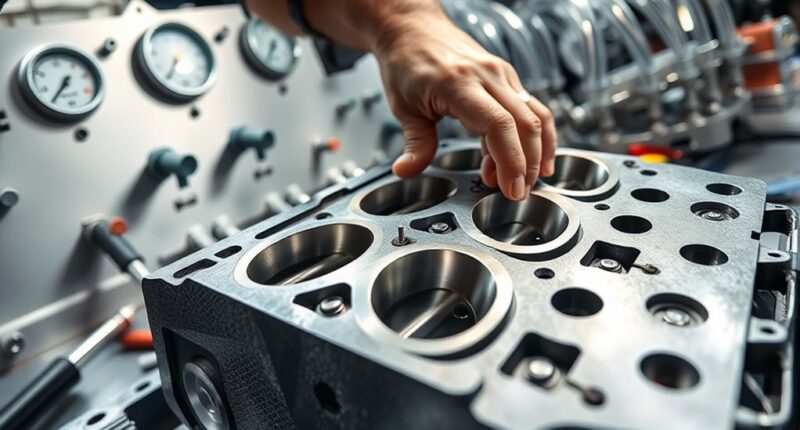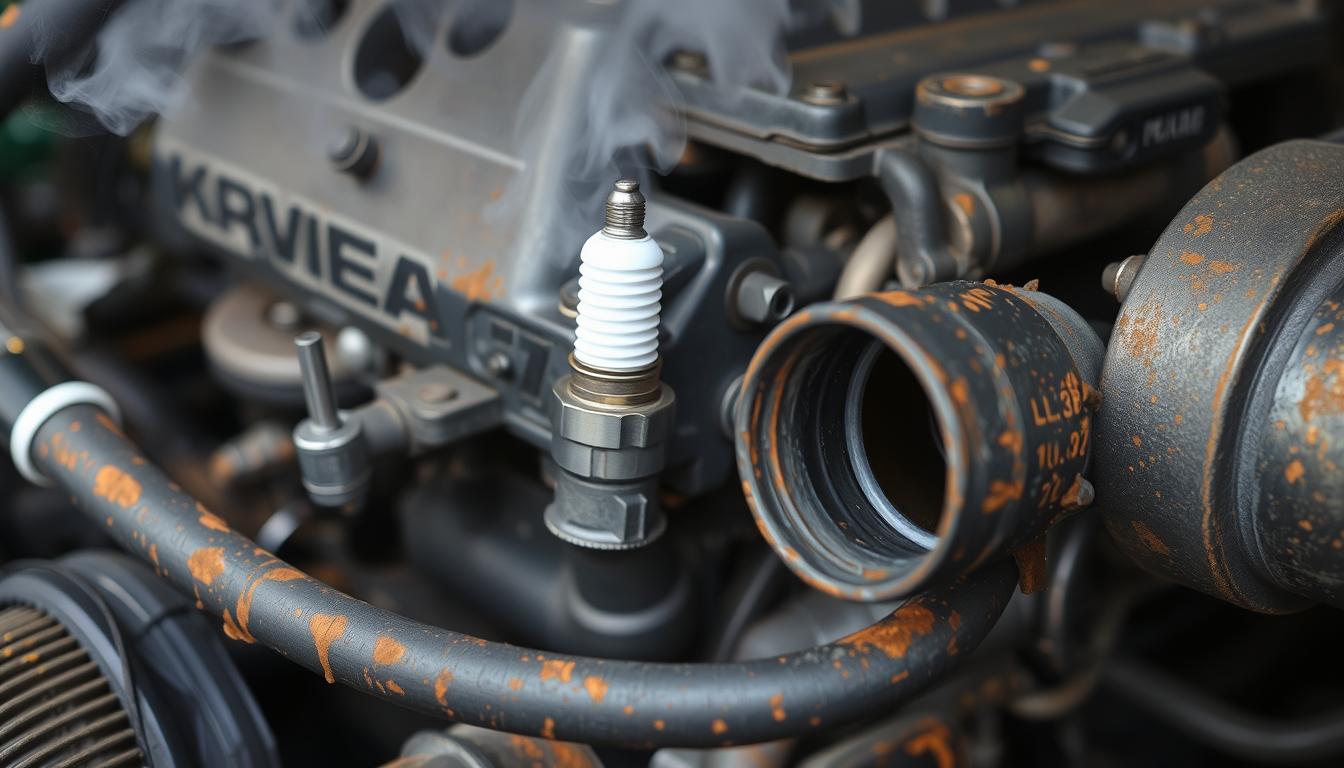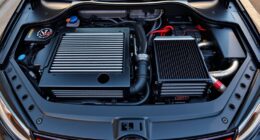A flow bench measures and analyzes airflow through engine cylinder heads, helping you optimize port design for better performance. It simulates real engine conditions by pushing air through ports at controlled pressures and recording the flow rate. This data lets you identify restrictions, turbulence, or sharp turns that hinder airflow. By using a flow bench, you can make data-driven adjustments to improve port efficiency, throttle response, and overall engine power. Exploring this process further reveals how to get the most out of your porting efforts.
Key Takeaways
- Flow benches simulate airflow through engine ports to evaluate and optimize port design.
- They measure airflow rates at controlled pressures to identify restrictions and turbulence.
- Proper setup involves attaching the cylinder head or port to the bench for accurate testing.
- Analyzing flow data guides port smoothing, reshaping, and modifications for better performance.
- Mastering flow bench use enables data-driven porting improvements, increasing engine efficiency and power.

Understanding the basics of cylinder head porting flow benches is essential if you want to optimize your engine’s performance. These benches are crucial tools that allow you to measure and analyze airflow through the engine’s ports, giving you critical insights into how well your port design is functioning. When you’re working on porting, the goal is to maximize airflow efficiency, which directly impacts power, throttle response, and overall engine performance. By accurately measuring airflow, you can identify restrictions or turbulence in your port design and make informed decisions to improve them. This process helps guarantee your modifications lead to real gains rather than just guesswork.
Flow benches work by simulating the airflow conditions inside your engine’s ports. You attach the cylinder head or port to the bench, which then pushes air through the port at controlled pressures and flow rates. During this process, you’ll use airflow measurement instruments—such as flow meters or digital sensors—to record how much air passes through the port at different pressures. These readings give you a clear picture of the port’s capacity and efficiency. The key is to understand how your port design influences airflow. For example, sharp turns, rough surfaces, or abrupt changes in cross-sectional area can create turbulence or flow separation, which reduces efficiency. The flow bench helps you identify these issues so you can smooth out the port’s interior, optimize its shape, and eliminate bottlenecks.
Effective port design isn’t just about increasing airflow; it’s about creating a smooth, consistent flow path that minimizes turbulence and maximizes velocity at the valve. With a flow bench, you can compare different port modifications side by side, seeing exactly how each change affects airflow measurement. This capability allows you to make incremental adjustments, such as reshaping the port runner, enlarging or refining the intake or exhaust paths, or modifying the valve seat area. The goal is to achieve a balanced flow that delivers high velocity without causing restrictions or flow separation. When you understand how each aspect of port design impacts airflow measurement, you can craft a port that complements your engine’s specific needs.
Additionally, integrating Hyundai Tuning techniques and tools can help optimize your porting process further, ensuring your modifications align with your engine’s overall performance goals.
In short, mastering the use of a cylinder head porting flow bench means you gain precise control over your port design. It’s a powerful way to turn theoretical modifications into tangible performance improvements. By carefully analyzing airflow data and making data-driven adjustments, you’ll enhance your engine’s breathing ability, ultimately boosting horsepower, efficiency, and throttle response. Whether you’re a hobbyist or a professional, understanding these basics gives you the foundation to push your engine to its full potential.
Frequently Asked Questions
How Do I Interpret Flow Bench Test Results Accurately?
To interpret flow bench test results accurately, you should analyze airflow patterns across different valve lifts to identify restrictions or improvements. Guarantee your test is properly calibrated before testing, as inaccurate calibration skews data. Compare your results against known benchmarks or other similar heads, focusing on consistent airflow levels at various lifts. This approach helps you make informed decisions on porting modifications and optimize your cylinder head for better performance.
What Are the Common Mistakes During Porting?
Think of porting as sculpting a masterpiece; one wrong move can ruin it. Common mistakes include rushing the process, neglecting proper valve selection, and ignoring gasket sealing. You might over-enthusiastically enlarge ports, which hampers airflow, or forget to check valve seat contact. Always guarantee your modifications match the cylinder’s design, and double-check gasket sealing to prevent leaks. Patience and precision keep your porting efforts on the winning path.
How Does Porting Affect Engine Reliability?
Porting your engine can improve fuel efficiency and emissions reduction, but if done improperly, it may harm reliability. You might experience uneven airflow, leading to engine knocking or overheating. Over-aggressive porting can weaken the head or cause leaks, decreasing durability. To maintain reliability, guarantee precise, balanced work, and avoid excessive modifications. Proper porting enhances performance without sacrificing the engine’s longevity, keeping your vehicle running smoothly and efficiently.
What Tools Complement Flow Bench Measurements?
When you’re working on porting, tools that complement flow bench measurements are essential. Airflow visualization tools, like smoke machines or fluorescent dyes, help you see how air moves through the ports, making sure your porting techniques optimize flow. These tools give you real-time feedback, allowing you to refine your work for better performance. Combining flow bench data with airflow visualization ensures you achieve precise, effective porting results that enhance your engine’s efficiency.
How Often Should Flow Bench Testing Be Performed?
When it comes to flow rate analysis and valve seat testing, you should perform flow bench testing regularly enough to keep your engine performing smoothly. Typically, once every few months or after significant modifications ensures you’re catching any issues early. Consistent testing helps maintain ideal airflow, identify potential problems, and refine your porting work. Remember, staying proactive with these tests keeps your engine running at peak efficiency without overdoing it.
Conclusion
Mastering flow bench basics is like tuning a finely crafted instrument—you get a surprise note when everything aligns perfectly. I once watched a fellow enthusiast improve his engine’s flow by just a few CFM, and suddenly, horsepower numbers soared. It’s a subtle art, but when you understand the nuances, each adjustment becomes a symphony of performance. Keep experimenting, and you’ll find your own rhythm in the world of porting, revealing power hidden within every cylinder.










